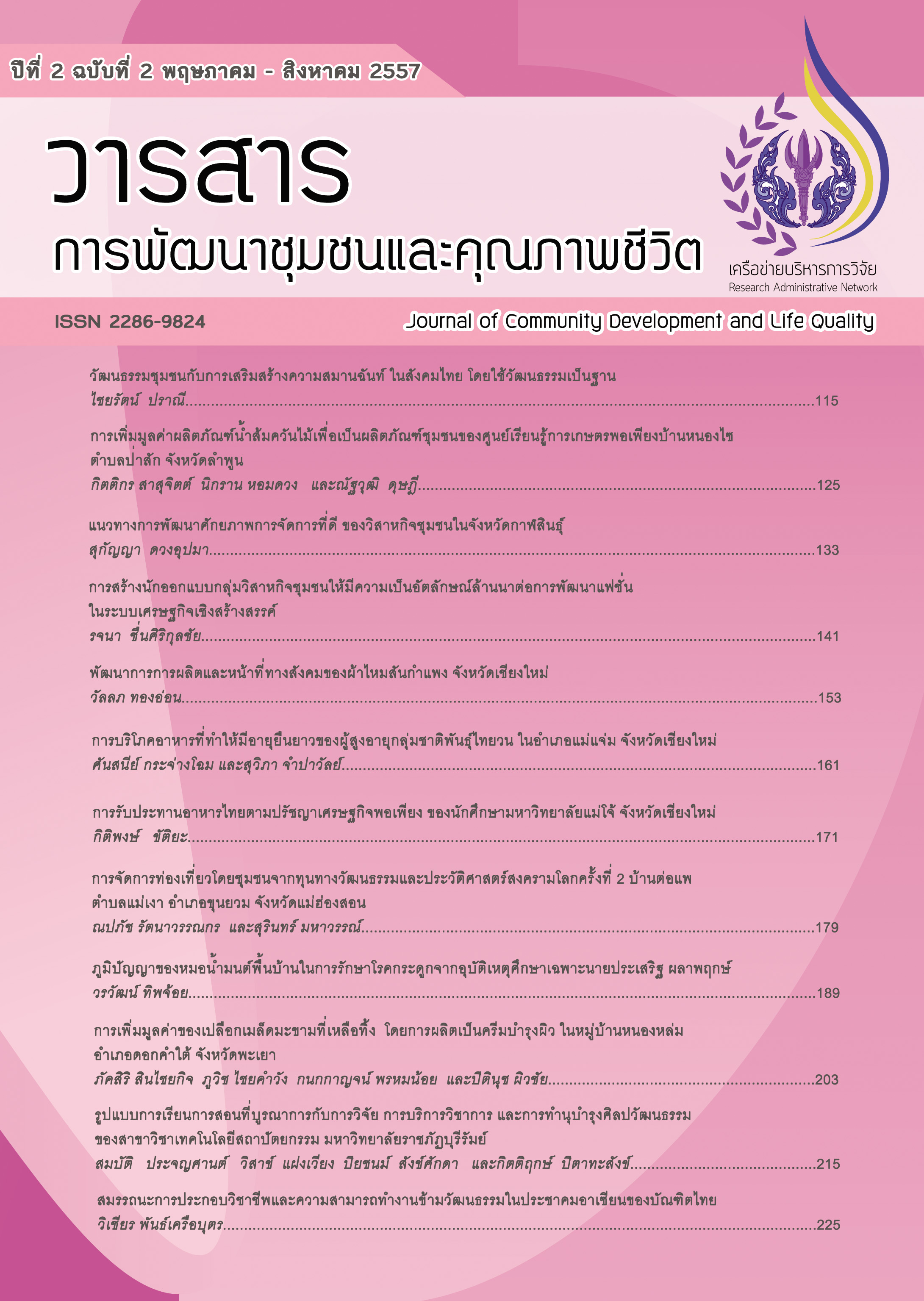การเพิ่มมูลค่าของเปลือกเมล็ดมะขามที่เหลือทิ้ง โดยการผลิตเป็นครีมบำรุงผิว ในหมู่บ้านหนองหล่ม อำเภอดอกคำใต้ จังหวัดพะเยา
Main Article Content
บทคัดย่อ
เปลือกเมล็ดมะขามที่เหลือทิ้งถูกนำไปสกัดสำหรับผลิตเป็นครีมบำรุงผิวโดยกลุ่มแม่บ้านตำบลหนองหล่ม อำเภอดอกคำใต้ จังหวัดพะเยา โรงงานของกลุ่มแม่บ้านตำบลหนองหล่มใช้เครื่องมือราคาไม่แพงในท้องถิ่นในการผลิตครีม ดังนั้นการผลิตต้องหากระบวนการสกัดที่เหมาะสมกับโรงงาน โดยพบว่าการสกัดเปลือกเมล็ดมะขามที่เหมาะสมกับโรงงาน คือ การใช้น้ำร้อนที่อุณหภูมิ 60 องศาเซลเซียส จากนั้นจึงนำสารสกัดน้ำที่ได้ไปผสมกับครีมพื้นเพื่อผลิตเป็นครีมบำรุงผิวและนำไปทดสอบลักษณะทางกายภาพและความคงตัวของครีมพบว่าครีมบำรุงผิวที่ผลิตโดยเภสัชกร (ครีมสูตรทดลอง) มีปัญหาเรื่องการเคลื่อนย้ายของสี ซึ่งไม่พบในครีมบำรุงผิวสูตรของโรงงาน (ครีมสูตรพัฒนาใหม่) ต่อมากลุ่มผู้วิจัยได้ศึกษาการยับยั้งเอนไซม์ไทโรซินเนสของครีมบำรุงผิวสูตรทดลองและสูตรพัฒนาใหม่ จากผลการทดลองเหล่านี้ชี้ให้เห็นว่าสารสกัดจากเปลือกเมล็ดมะขามน่าจะมีคุณสมบัติในการผลิตเป็นครีมเพื่อป้องกันผิวหนังจากอนุมูลอิสระและทำให้ผิวขาวขึ้นได้ การทดลองสุดท้ายกลุ่มผู้วิจัยได้นำครีมบำรุงผิวสูตรโรงงานภายใต้ตราสินค้าแม่แสงดีไปประเมินความพึงพอใจโดยกลุ่มผู้ใช้ผลิตภัณฑ์ พบว่ามากกว่า 80% ของผู้ใช้มีความพึงพอใจในครีมบำรุงผิวสูตรนี้ อย่างไรก็ดี เรื่องของสี กลิ่น และความข้นหนืดของครีมบำรุงผิวยังจำเป็นต้องมีการปรับปรุงต่อไป
Article Details
กองบรรณาธิการขอสงวนสิทธิ์ในการตรวจและแก้ไขบทความที่เสนอเพื่อตีพิมพ์ในวารสารการพัฒนาชุมชนและคุณภาพชีวิต
บทความหรือข้อความคิดเห็นใด ๆ ที่ปรากฏในวารสารการพัฒนาชุมชนและคุณภาพชีวิต เป็นวรรณกรรมของผู้เขียนโดยเฉพาะคณะผู้จัดทำไม่จำเป็นต้องเห็นด้วย และไม่ใช่ความรับผิดชอบของมหาวิทยาลัยและคณะผู้จัดทำ / บรรณาธิการ
เอกสารอ้างอิง
สุวจี แตงอ่อน. 2557. แนวทางพัฒนาชุมชนต้นตาลเพื่อเตรียมรับภาวะโลกร้อนในแนวทางปรัชญาของเศรษฐกิจพอเพียง. วารสารพัฒนาชุมชนและคุณภาพชีวิต 2(1): 23-25.
ศิริพร เหลืองกอบกิจ. 2545. มะขาม (Tamarind). จุลสารข้อมูลสมุนไพร 19(2): 4-13.
Ando, H., H. Kondoh, M. Ichihashi and V.J. Hearing. 2007. Approaches to identify inhibitors of melanin biosynthesis via the quality control of tyrosinase, Journal of Investigative Dermatology 127(4): 751-761.
Lindroth, R.L. and P.A. Koss. 1996. Preservative of Salicaceae leaves for phytochemical analysis: further assessment. Journal of Chemical Ecology 22: 765-771.
Lourith, N. M. Kanlayavattanakul and S. Chanpirom. 2009. Free radical scavenging efficacy of tamarind seed coat and its cosmetics application. Journal of Health Research 23(4): 159-162.
Luengthanaphol, S., D. Mongkholkhajornsilp, S. Douglas, P. Douglas, L. Pengsopa and S. Pongamphai. 2004. Extraction of antioxidants from sweet Thai tamarind seed coat-preliminary experiments. Journal Food Engineering 63: 247-252.
Orians, C.M. 1995. Preservative leaves for tannin and phenolic glycoside analyses: a comparison of methods using three willow taxa. Journal of Chemical Ecology 21: 1235-1243.
Siddhuraju, P. 2007. Antioxidant activity of polyphenolic compounds extracted from defatted raw and dry heated Tamarindus indica seed coat. Lebensmittel-Wissenschaft und-Technologie (LWT)-Food Science and Technology 40(6): 982-990.
Sinchaiyakit, P., Y. Ezure, S. Sriprang, S. Pongbangpho, N. Povichit and M. Suttajit. 2011. Tannins of tamarind seed husk: preparation, structural characterization and antioxidant activity. Natural Product Communication 6(6): 829-834.
Slinkard, K. and V.L. Singleton. 1977. Total phenol analysis: automation and comparison with manual methods. American Journal of Enology and Viticulture 28: 49-55.
Tsuda, T., K. Ohshima, A. Yamamoto, S. Kawakishi, and T. Osawa. 1994. Antioxidative components isolated from the seed of tamarind (Tamarindus indica L.). Journal of Agriculture Food Chemistry 42(12): 2671-2674.
Van Sumere, C.F., H. Geiger, D. Brai, G. Fockenier, K. Vande Casteele, M. Martens, R. Hansflaer and L. Gebaert. 1983. Freeze-drying and analysis of plant and other biological material. Analytical Biochemistry 131: 530-532.


